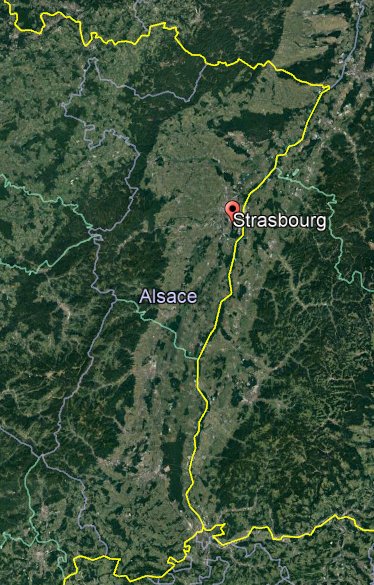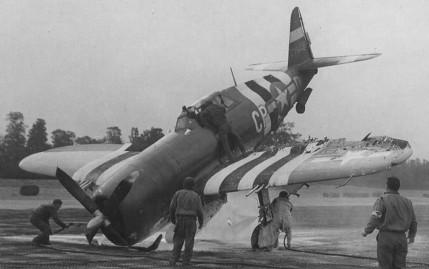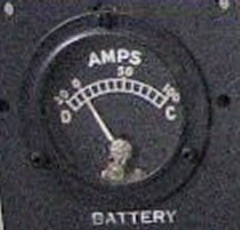ALSACAT-1944-10-12-STRASBOURG-1
A "Top Secret Urgent" message sent to the war ministry on October 26, 1944, is said to have reported an incident on October 12, 1944, involving four planes of the 358th Fighter-Bomber Group of the Ninth Air Force of the USA that were flying near Strasbourg.
The first pilot reported engine trouble and noise on the radio while flying from north to south at 11,000 to 13,000 feet.
The second pilot complained of engine trouble and strong interference on the radio, and also reported that the ammeter showed 50 amps when the radio noise and the engine difficulties were occurring. At a time when the sounds of the radio were excessive, the radio was turned off and the ammeter returned to normal.
The third pilot reported excessive radio noise and engine trouble simultaneously.
The fourth pilot first noticed engine trouble, and then static on the radio.
All radios were on the same channel at the time of the incident. The four pilots all tried to regulate the engine handling the mixture of propellant and control of gas, but in vain.
Nothing strange appears to have been observed in the sky by the pilots during these incidents. But because it happened at a time when other pilots reported mysterious balls of light, soon called "Foo-Fighters", and that radio and engine malfunctions are present in UFO sightings reports later, the case was reported in a book about WWII UFOs, as possibly related to UFOs.
| Date: | October 12, 1944 |
|---|---|
| Time: | ? |
| Duration: | ? |
| First known report date: | 1944 |
| Reporting delay: | Minutes, days? |
| Department: | Bas-Rhin |
|---|---|
| City: | Strasbourg |
| Place: | In planes. |
| Latitude: | 48.581 |
| Longitude: | 7.747 |
| Uncertainty radius: | 20 km |
| Number of alleged witnesses: | 4 |
|---|---|
| Number of known witnesses: | ? |
| Number of named witnesses: | 0 |
| Witness(es) ages: | Adults. |
| Witness(es) types: | Military pilots. |
| Reporting channel: | Military operation report? |
|---|---|
| Type of location: | In planes in flight. |
| Visibility conditions: | ? |
| UFO observed: | No |
| UFO arrival observed: | N/A |
| UFO departure observed: | N/A |
| Entities: | No |
| Photographs: | N/A. |
| Sketch(s) by witness(es): | N/A. |
| Sketch(es) approved by witness(es): | N/A. |
| Witness(es) feelings: | ? |
| Witnesses interpretation: | ? |
| Hynek: | ? |
|---|---|
| ALSACAT: | Unexplained. Not necessarily related to UFOs. |
[Ref. jdy1:] JAMES E. DELEHANTY:
An incident on October 12, 1944 in the vicinity of Strasbourg, France caused aircraft engine roughness and excessive radio noise. It was a strange experience that greatly troubled the War Department.
The source is indicated as "STRANGE COMPANY Military Encounters with UFOs in World War II" by Keith Chester, Anomalist Books, 2007.
[Ref. snu1:] "SATURDAY NIGHT UFORIA" WEBSITE:
The website provides the following article from the September 6, 1944 edition of the Zanesville, Ohio, Signal, written by Major Alexander P. de Seversky, a renowned aviator, author and expert in strategic aerial bombing.
By Major Alexander P. de Seversky
The Nazis talk big about new and more devastating secret weapons. Their claims of the potency of the as yet unrevealed weapons, indeed, are in direct proportion to the speed and size of their defeats.
These threats, of course, are the consequence of two facts: (1) Dire military necessity -- the need that is, to match the overwhelming Allied quantities of force by some surprise innovation; and (2) the importance of bolstering German morale at home and in the field.
From many directions even the possibility that the Nazis are preparing to use poison gas against us as a "weapon of desperation" is raised. Should this be true, they would be flirting with mass extermination. For if ever a nation could ill afford to invoke this weapon, it is Germany today.
With our present decisive superiority in the skies over Germany, we are in the most advantageous position to get the maximum results from the use of poison gas in retaliation. Unless they have lost the last shred of the instinct of self-preservation, it is hard to believe that the Germans would bring into play a method of destruction that could only boomerang against them.
As to any other new or secret weapon, the vital element in the equation is the German lack of industrial capacity, as a result of our strategic bombardment. No matter how remarkable any novel weapon may be, its effectiveness will depend on the volume in which it can be produced. The rapidity with which the German industrial potential has shrunk, plus our ability to continue shrinking it, is the best guarantee we have against Hitler's secret weapons, no matter how deadly they may be.
There is room for speculation as to the character of the new weapons the Germans may be experimenting with. The main threat to Germany, as it draws its forces inside its own frontiers, is undoubtedly represented by Allied air bombardment. That is the factor which cancels every real possibility of turning Germany into a "fortress," within which it can produce these marvel weapons to repel the Allied assault with hideous losses to our forces.
Therefore, from the German point of view, the strategic bomber must be destroyed. And it is reasonable to assume that they must be thinking and searching for some means of accomplishing this. One attempt along these lines has already had its debut, in the German jet-propelled fighter using rocket ammunition. This innovation for a while loomed dangerously. It was able to elude our fighter escorts and inflict serious damage on our bombing forces. But the damage has not been decisive and could not impede our operations. Again it was inadequate industrial capacity, limiting the number of these planes they could put in the skies, which played into our hands.
Another solution which military scientists know is always possible because it has so often been discussed and experimented with, comes to mind. We must assume that the Germans have been seeking some method of detonating explosives while they are still in their magazines -- that is to say, to explode bombers before they are dropped and thus destroy the planes which carry them.
As a military problem there is nothing new about this, but a solution, as far as we know, has not yet been found. If some method could be found to detonate T.N.T., let us say, by remote means, the whole air picture would change -- at least until a countermeasure could be developed.
One day, of course, some method will be found, either by firing shells containing the appropriate detonating charge or perhaps through some form of electronic force. But even assuming the worst, that Germany has such a solution up its sleeve, our strategic bombardment would be stymied only temporarily, and certainly not long enough to alter the course of the war.
The respite to German industry and the lift to Nazi morale would last only as long as it took us to perfect counter-measures. In the first place, the explosive itself could be substituted for new ones already under development, and the enemy's detonators would be ineffective. The Germans would then face the problem of discovering a new method. In addition, bomb bays could be appropriately armored and, should we have to face any electronic device, ray or other method of remote detonation, they could be correspondingly shielded. Whatever the threat, a remedy would be found to match. Given our vastly superior resources and unmolested industrial capacity, it would be once more merely a question of time before we reestablished our superiority.
All of this, of course, is in the realm of speculation. The best the Germans can hope for from the most miraculous weapons would be a delay. Since they failed to provide themselves with a strategic air force which would assume command of the air over the British Isles in order to destroy its industrial capacity and isolate it from the rest of the world, their doom is sealed.
And it may have been such German experiments in disabling aircraft or exploding their bombs in flight which resulted in an unnerving experience by four pilots of the Ninth Air Force's 358th Fighter-Bomber Group on October 12, 1944 near Strasbourg, at Germany's border with France, as related in a "Top Secret Urgent" message sent to the War Department on October 26, 1944...
Pilot one reported rough engine and noise on radio while flying north south at 11,000 to 13,000 feet, pilot two complained of rough engine and excessive radio interference, also that ammeter showed fifty amps when noise and engine roughness were present, at one time when radio noise was excessive radio was turned off and ammeter returned to normal, pilot three mentioned excessive radio noise and engine roughness simultaneously, pilot four first noticed engine roughness and afterwards accompanying static on the radio.
Radios of all here on "C" channel at time of observations. All four pilots attempted to smooth out the engine by manipulation of propeller mixture and throttle control to no avail.

|
The 358th Fighter Group of the Army Air Force was then in France, in Vitry-le-Francois, since September 14, 1944, and conducted escort and ground attack operations on eastern France and Germany.
They used the powerful single-seat fighter Republic P-47 "Thunderbolt".

|
Above: a P-47D of the 358th in France after a crash-landing due to German flak damages.
I did not find the amperage of the electrical circuit of the P-47, but it was using 24 volts power supplied by a battery ("P-47 Thunderbolt at War," page 32). I found a picture where we see the ammeter shows 0 to 100 amps, 50 amps corresponding to the halfway point:

|
In the 16 reports of "Foo-Fighters" above Alsace in the following months I've identified, there is not a single instance of engine problems or radio noise at the time of observation.
The Germans were using for their night fighters airborne radars like the "Lichtenstein" series, operating in the UHF radio like the P-47 radio; one might assume that the simultaneous radio interference was caused by such radar sets, or by corresponding jamming. However, the simultaneous engine problems obviously cannot be explained like this. Contrary to some never documented claims, or speculation as in [snu1], the Germans had had no means of disrupting enemy aircraft engines.
For me the incident remains unexplained, but not necessarily inexplicable by trivial causes. It deserved to be reported, but it does not seem to me to be necessarily related to UFOs. Could these engine troubles be explained by bad fuel?
Unexplained. Not necessarily related to UFOs.
* = Source is available to me.
? = Source I am told about but could not get so far. Help needed.
| Main author: | Patrick Gross |
|---|---|
| Contributors: | None |
| Reviewers: | None |
| Editor: | Patrick Gross |
| Version: | Create/changed by: | Date: | Description: |
|---|---|---|---|
| 0.1 | Patrick Gross | September 3, 2014 | Creation, [kcr1], [jdy1], [snu1]. |
| 1.0 | Patrick Gross | September 3, 2014 | First published. |